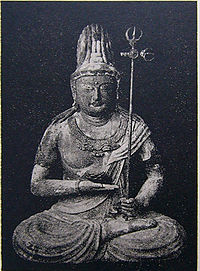
Akasagarbha
Encyclopedia

Tibetan language
The Tibetan languages are a cluster of mutually-unintelligible Tibeto-Burman languages spoken primarily by Tibetan peoples who live across a wide area of eastern Central Asia bordering the Indian subcontinent, including the Tibetan Plateau and the northern Indian subcontinent in Baltistan, Ladakh,...
: Namkhai Nyingpo (Wylie: Nam-mkha
Korean language
Korean is the official language of the country Korea, in both South and North. It is also one of the two official languages in the Yanbian Korean Autonomous Prefecture in People's Republic of China. There are about 78 million Korean speakers worldwide. In the 15th century, a national writing...
: 허공장보살, Japanese
Japanese language
is a language spoken by over 130 million people in Japan and in Japanese emigrant communities. It is a member of the Japonic language family, which has a number of proposed relationships with other languages, none of which has gained wide acceptance among historical linguists .Japanese is an...
: Kokūzō Bosatsu) is one of the eight great bodhisattva
Bodhisattva
In Buddhism, a bodhisattva is either an enlightened existence or an enlightenment-being or, given the variant Sanskrit spelling satva rather than sattva, "heroic-minded one for enlightenment ." The Pali term has sometimes been translated as "wisdom-being," although in modern publications, and...
s. His name can be translated as "boundless space treasury" or "void store" as his wisdom is said to be boundless as space itself. He is sometimes known as the twin brother of the "earth store" bodhisattva Ksitigarbha
Ksitigarbha
Ksitigarbha is a bodhisattva primarily revered in East Asian Buddhism, usually depicted as a Buddhist monk in the Orient. The name may be translated as "Earth Treasury", "Earth Store", "Earth Matrix", or "Earth Womb"...
, and is even briefly mentioned in the Sutra of The Great Vows of Ksitigarbha Bodhisattva
Sutra of The Great Vows of Ksitigarbha Bodhisattva
The Sūtra of The Great Vows of Bodhisattva is one of the more popular Buddhist sutras in Chinese Mahāyāna Buddhism. The sutra tells basically of how became a bodhisattva by making great vows to rescue other sentient beings, and a description of how he followed filial piety in his past lifetimes....
.
Kūkai
Kukai
Kūkai , also known posthumously as , 774–835, was a Japanese monk, civil servant, scholar, poet, and artist, founder of the Shingon or "True Word" school of Buddhism. Shingon followers usually refer to him by the honorific titles of and ....
(Kōbō-Daishi), the founder of Shingon Buddhism
Shingon Buddhism
is one of the mainstream major schools of Japanese Buddhism and one of the few surviving Esoteric Buddhist lineages that started in the 3rd to 4th century CE that originally spread from India to China through traveling monks such as Vajrabodhi and Amoghavajra...
, is said to have repeatedly chanted a mantra
Mantra
A mantra is a sound, syllable, word, or group of words that is considered capable of "creating transformation"...
of Ākāśagarbha as a young Buddhist acolyte. As he chanted the mantra, he experienced a vision whereby Ākāśagarbha told him to go to China to seek understanding of the Mahavairocana Sutra.
Mantra

Mantra
A mantra is a sound, syllable, word, or group of words that is considered capable of "creating transformation"...
of Ākāśagarbha is popularly used by Shingon Buddhists
Shingon Buddhism
is one of the mainstream major schools of Japanese Buddhism and one of the few surviving Esoteric Buddhist lineages that started in the 3rd to 4th century CE that originally spread from India to China through traveling monks such as Vajrabodhi and Amoghavajra...
, Chinese Esoteric Buddhists, and artists. It is believed to give rise to wisdom and creativity, and dispel ignorance.
- Chinese: Na Mo Xu Kong Zang Pu Sa
- Vietnamese: Nam Mo Hu Khong Tang Bo Tat
- Translation: Blessed be Akasagarbha Bodhisattva,
A different mantra is used for both Japanese
Japanese language
is a language spoken by over 130 million people in Japan and in Japanese emigrant communities. It is a member of the Japonic language family, which has a number of proposed relationships with other languages, none of which has gained wide acceptance among historical linguists .Japanese is an...
and Sanskrit
Sanskrit
Sanskrit , is a historical Indo-Aryan language and the primary liturgical language of Hinduism, Jainism and Buddhism.Buddhism: besides Pali, see Buddhist Hybrid Sanskrit Today, it is listed as one of the 22 scheduled languages of India and is an official language of the state of Uttarakhand...
:
- Japanese: nōbō akyasha kyarabaya on arikya mari bori sowaka.
- Sanskrit: namo ākāśagarbhāya oṃ ārya kamari mauli svāhā.
- English Translation: Wish the whole universe, "OM", to pray all human beings flourish with all dedication.
- Chinese Translation: 南牟,阿迦捨,揭婆耶,唵,阿唎,迦麼唎,慕唎,莎訶!
Tantric rituals surrounding him are only given to students initiated in esoteric Buddhist lineages by an approved teacher. Currently the Chinese (Hanmi) Esoteric School is teaching his tantric ritual to the general public.
External links
- Japanese Buddhist Statuary: Kokuzo
- The Koyasan Shingon-shu Lay Practitioner's Daily Service
- Icons of Akasagarbha Bodhisattva
- Teaching available from The Chinese (Hanmi) Esoteric School to the public
- Head Quarters of The Chinese (Hanmi) Esoteric School:Prajna Akasagarbha Teachings available to the general public

